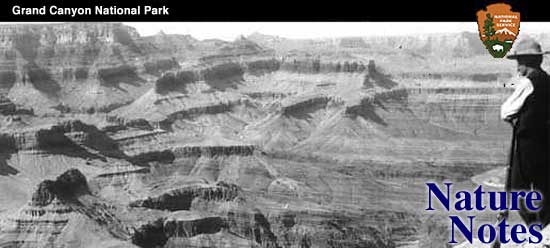

|
By Ranger Naturalist Clyde C. Searl RECENTLY, while cataloging the type photographs belonging to the department of research and education of the Grand Canyon National Park, three splendid photographs of an insect were found to which were attached two letters. The first letter, dated April 3, 1928, was written by Maynard L. Parker of Brooklyn, N. Y., and addressed to the Information Bureau of the Grand Canyon National Park. It was a query in regard to an insect which Dr. Parker had seen and photographed at the Grand Canyon in May, 1927. An excerpt from the letter reads: "The insect was very common, crawling on the tires of the car and on the trees. It only took about half an hour for it to change from a crawling insect to a flying one". Apparently the letter just referred to was given to Park Naturalist Glen E. Sturdevant, now deceased, for an answer. Mr. Sturdevant informed Mr. Parker that the insect in question was a cicada, but he was unable to give either the generic or specific name of the insect. Mr. Sturdevant wrote: "They were particularly abundant on the South Rim of Grand Canyon during May and June, 1927. That is the only year I have seen them during my three years at this place". During May, 1931, the writer collected a number of cicadas on the South Rim of Grand Canyon, later determined as Platypedia lutea Davis. During two other seasons at the park the insect had not been collected. In fact, many people who had spent several years here did not remember ever having seen it before, and inasmuch as it is an insect which readily attracts attention by its habits, any occurrence would probably have been noted. An account of the general habits of cicadas appears in Grand Canyon Nature Notes. (Vol. 5, No. 7, May, 1931). In that article was mentioned the fact that the length of the life cycle of the local cicada was unknown.
As soon as the photographs sent by Mr. Parker came to the writer's attention, a specimen collected in May, 1931, was secured and compared with the photographs. The wing venation on the photograph determined that the cicada observed in 1927 and referred to by Mr. Parker, was without doubt Platypedia lutea Davis, and thus was established the local life cycle of the particular insect. Although it only took half an hour to change from a crawling insect to a flying one as observed by Mr. Parker, the insect actually required four years from the time the egg was laid until the adult stage was reached. Reference books are not locally available, so it is impossible to check up on the life cycle of Platypedia lutea Davis, but the writer is reasonably certain that four years is the correct length. Many cicadas require a much longer life cycle, such as the seventeen year "locust" of the middle west. Many "crops" of cicadas overlap in their life cycles, thus giving the appearance that their cycle is short. Only by segregation and careful observation can this be definitely determined. Climatic conditions also tend to vary the length of a life cycle. | ||||||
| <<< Previous | > Cover < | Next >>> |
vol7-5f.htm
14-Oct-2011